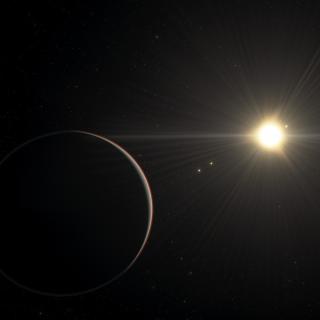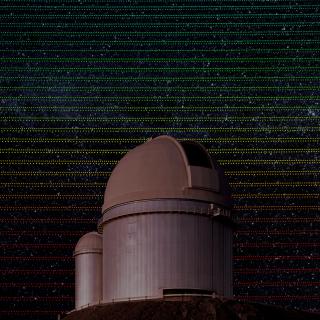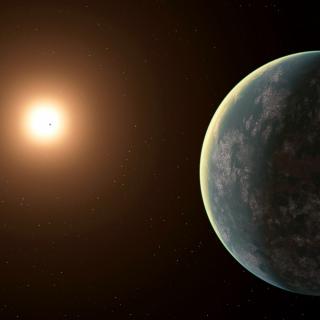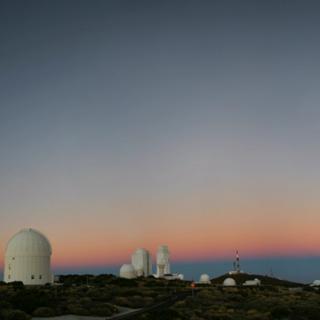Grants related:
General
The search for life in the universe has been driven by recent discoveries of planets around other stars (known as exoplanets), becoming one of the most active fields in modern astrophysics. The growing number of new exoplanets discovered in recent years and the recent advance on the study of their atmospheres are not only providing new valuable information about its physical properties, but also allowing to constrain the properties of the Solar system's planets within a more global context. The field is approaching to the important discovery of the first potentially habitable planets and encouraging more detailed studies of them. With the launching of upcoming related satellites like JWST, CHEOPS, TESS, ARIEL and PLATO, the exoplanets field faces a bright future.
It is for this reason that this field is aid of, and at the same time promotes, the development of increasingly sensitive and stable instrumentation for both, ground-based telescopes and space missions. Our group is particularly prepared for these two fronts. On the one hand, during the last years we have developed observational and reduction techniques of exoplanet transits data for the ORM telescopes, ours being one of the most productive groups in the exploitation of GTC. On the other hand, all ESA space missions (present and future) related to exoplanets have one or more components of the project as CoIs. Within the frame of this project, we intend that IAC researchers maintain an advantageous position regarding the operation of OSIRIS and CanariCam, first light
GTC's instruments, and participate in the construction, commissioning and operation of new instruments such as the high resolution optical spectrograph HORUS at GTC. The exploitation of the photometry and spectroscopy of transits with LIRIS at WHT is also one of our principal interests, especially in preparation for the installation in 2015 of EMIR on the GTC .
To summarize, the project "Exoplanets and Astrobiology" will focus on these four action lines:
1) The characterization of atmospheric and physical properties of exoplanets (GTC, WHT, ARIEL, HARPSN, CARMENES, ESPRESSO, etc. ..)
2) The search and confirmation of exoplanets by transits techniques (CoRoT, Kepler, K2, CHEOPS, XO, LCOGT, W FC, DISH, etc. ..)
3) The search and confirmation of exoplanet by radial velocity techniques (HARPSN, HORUS, LCOGT, SONG, CARMENES)
4) Astrobiology
Members
Results
- Detection of He in the atmosphere of an exoplanet from the ground, published in Science
- Detection of a super-earth around Barnard star, published in Nature
- Detection of the first TESS planets, with several papers of high relevance
- Discovery of Na and Halpha features in the spectrum of KELT-20b with TNG
- Publication of the Handbook of Exoplanets, the most extensive work of reference in the field of exoplanets. The Handbook was edited by members of our group, and includes contributions by about 300 experts worldwide, including 12 members of IAC.
Scientific activity
Related publications
-
Sub-stellar companions of intermediate-mass stars with CoRoT: CoRoT-34b, CoRoT-35b, and CoRoT-36b
Theories of planet formation give contradicting results of how frequent close-in giant planets of intermediate mass stars (IMSs; $1.3\le M_{\star }\le 3.2\, \mathrm{M}_{\odot }$) are. Some theories predict a high rate of IMSs with close-in gas giants, while others predict a very low rate. Thus, determining the frequency of close-in giant planets of
Sebastian, D. et al.Advertised on:
102022 -
The GAPS Programme at TNG. XXXVII. A precise density measurement of the young ultra-short period planet TOI-1807 b
Context. Great strides have been made in recent years in the understanding of the mechanisms involved in the formation and evolution of planetary systems. Despite this, many observational findings have not yet been corroborated by astrophysical explanations. A fine contribution to the study of planetary formation processes comes from the study of
Nardiello, D. et al.Advertised on:
82022 -
A stellar occultation by the transneptunian object (50000) Quaoar observed by CHEOPS
Context. Stellar occultation is a powerful technique that allows the determination of some physical parameters of the occulting object. The result depends on the photometric accuracy, the temporal resolution, and the number of chords obtained. Space telescopes can achieve high photometric accuracy as they are not affected by atmospheric
Morgado, B. E. et al.Advertised on:
82022 -
The HD 260655 system: Two rocky worlds transiting a bright M dwarf at 10 pc
We report the discovery of a multiplanetary system transiting the M0 V dwarf HD 260655 (GJ 239, TOI-4599). The system consists of at least two transiting planets, namely HD 260655 b, with a period of 2.77 d, a radius of R b = 1.240 ± 0.023 R ⊕, a mass of M b = 2.14 ± 0.34 M ⊕, and a bulk density of ρ b = 6.2 ± 1.0 g cm −3, and HD 260655 c, with a
Luque, R. et al.Advertised on:
82022 -
TESS Hunt for Young and Maturing Exoplanets (THYME). VII. Membership, Rotation, and Lithium in the Young Cluster Group-X and a New Young Exoplanet
The public, all-sky surveys Gaia and TESS provide the ability to identify new young associations and determine their ages. These associations enable study of planetary evolution by providing new opportunities to discover young exoplanets. A young association was recently identified by Tang et al. and Fürnkranz et al. using astrometry from Gaia
Newton, Elisabeth R. et al.Advertised on:
92022 -
The GAPS Programme at TNG XXXIX. Multiple Molecular Species in the Atmosphere of the Warm Giant Planet WASP-80 b Unveiled at High Resolution with GIANO-B
Detections of molecules in the atmosphere of gas giant exoplanets allow us to investigate the physico-chemical properties of the atmospheres. Their inferred chemical composition is used as tracer of planet formation and evolution mechanisms. Currently, an increasing number of detections is showing a possible rich chemistry of the hotter gaseous
Carleo, Ilaria et al.Advertised on:
92022 -
Uncovering the true periods of the young sub-Neptunes orbiting TOI-2076
Context. TOI-2076 is a transiting three-planet system of sub-Neptunes orbiting a bright (G = 8.9 mag), young (340 ± 80 Myr) K-type star. Although a validated planetary system, the orbits of the two outer planets were unconstrained as only two non-consecutive transits were seen in TESS photometry. This left 11 and 7 possible period aliases for each
Osborn, H. P. et al.Advertised on:
82022 -
Transmission spectroscopy of MASCARA-1b with ESPRESSO: Challenges of overlapping orbital and Doppler tracks
Atmospheric studies at high spectral resolution have shown the presence of molecules, neutral and ionised metals, and hydrogen in the transmission spectrum of ultra-hot Jupiters, and have started to probe the dynamics of their atmospheres. We analyse the transmission spectrum of MASCARA-1b, one of the densest ultra-hot Jupiters orbiting a bright (V
Casasayas-Barris, N. et al.Advertised on:
82022 -
Four sub-Jovian-mass planets detected by high-cadence microlensing surveys
Aims: With the aim of finding short-term planetary signals, we investigated the data collected from current high-cadence microlensing surveys. Methods: From this investigation, we found four planetary systems with low planet-to-host mass ratios, including OGLE-2017-BLG-1691L, KMT-2021-BLG-0320L, KMT-2021-BLG-1303L, and KMT-2021-BLG-1554L. Despite
Han, Cheongho et al.Advertised on:
82022 -
Detailed stellar activity analysis and modelling of GJ 832. Reassessment of the putative habitable zone planet GJ 832c
Context. Gliese-832 (GJ 832) is an M2V star hosting a massive planet on a decade-long orbit, GJ 832b, discovered by radial velocity (RV). Later, a super Earth or mini-Neptune orbiting within the stellar habitable zone was reported (GJ 832c). The recently determined stellar rotation period (45.7 ± 9.3 days) is close to the orbital period of putative
Gorrini, P. et al.Advertised on:
82022 -
A super-Earth orbiting near the inner edge of the habitable zone around the M4.5 dwarf Ross 508
We report the near-infrared radial velocity (RV) discovery of a super-Earth planet on a 10.77 d orbit around the M4.5 dwarf Ross 508 (J mag = 9.1). Using precision RVs from the Subaru Telescope IRD (InfraRed Doppler) instrument, we derive a semi-amplitude of $3.92^{+0.60}_{-0.58}\:\mbox{m}\:{\mbox{s}^{-1}}$, corresponding to a planet with a minimum
Harakawa, Hiroki et al.Advertised on:
82022 -
Large Interferometer For Exoplanets (LIFE). I. Improved exoplanet detection yield estimates for a large mid-infrared space-interferometer mission
Context. One of the long-term goals of exoplanet science is the atmospheric characterization of dozens of small exoplanets in order to understand their diversity and search for habitable worlds and potential biosignatures. Achieving this goal requires a space mission of sufficient scale that can spatially separate the signals from exoplanets and
Quanz, S. P. et al.Advertised on:
82022 -
Benchmark tests of transmission spectroscopy using transiting white dwarfs
Context. Ground-based transit observations are affected by both telluric absorption and instrumental systematics, which can affect the final retrieved transmission spectrum of an exoplanet. To account for these effects, a better understanding of the impact of different data analyses is needed to improve the accuracy of the retrieved transmission
Jiang, C. et al.Advertised on:
82022 -
TOI-1452 b: SPIRou and TESS Reveal a Super-Earth in a Temperate Orbit Transiting an M4 Dwarf
Exploring the properties of exoplanets near or inside the radius valley provides insight on the transition from the rocky super-Earths to the larger, hydrogen-rich atmosphere mini-Neptunes. Here, we report the discovery of TOI-1452b, a transiting super-Earth (R p = 1.67 ± 0.07 R ⊕) in an 11.1 day temperate orbit (T eq = 326 ± 7 K) around the
Cadieux, Charles et al.Advertised on:
92022 -
The TESS-Keck Survey. XIII. An Eccentric Hot Neptune with a Similar-mass Outer Companion around TOI-1272
We report the discovery of an eccentric hot Neptune and a non-transiting outer planet around TOI-1272. We identified the eccentricity of the inner planet, with an orbital period of 3.3 days and R p,b = 4.1 ± 0.2 R ⊕, based on a mismatch between the observed transit duration and the expected duration for a circular orbit. Using ground-based radial
MacDougall, Mason G. et al.Advertised on:
92022 -
The polar orbit of the warm Neptune GJ 436b seen with VLT/ESPRESSO
GJ 436b might be the prototype of warm Neptunes that have undergone late migration induced by an outer companion. Precise determination of the orbital architecture of such systems is critical to constraining their dynamical history and evaluating the role of delayed migration in the exoplanet population. To this purpose we analyzed the Rossiter
Bourrier, V. et al.Advertised on:
72022 -
Physical properties and trigonometric distance of the peculiar dwarf WISE J181005.5−101002.3
Aims: Our goal is to characterise the physical properties of the metal-poor brown dwarf population. In particular, we focus on the recently discovered peculiar dwarf WISE 1810055−1010023. Methods: We collected optical iz and near-infrared J-band imaging on multiple occasions over 1.5 years to derive accurate trigonometric parallax and proper motion
Lodieu, N. et al.Advertised on:
72022 -
The TESS Grand Unified Hot Jupiter Survey. I. Ten TESS Planets
Hot Jupiters-short-period giant planets-were the first extrasolar planets to be discovered, but many questions about their origin remain. NASA's Transiting Exoplanet Survey Satellite (TESS), an all-sky search for transiting planets, presents an opportunity to address these questions by constructing a uniform sample of hot Jupiters for demographic
Yee, Samuel W. et al.Advertised on:
82022 -
A novel framework for semi-Bayesian radial velocities through template matching
Context. The ability to detect and characterise an increasing variety of exoplanets has been made possible by the continuous development of stable, high-resolution spectrographs and the Doppler radial velocity (RV) method. The cross-correlation function (CCF) method is one of the traditional approaches used to derive RVs. More recently, template
Silva, A. M. et al.Advertised on:
72022 -
The CARMENES search for exoplanets around M dwarfs. Rotational variation in activity indicators of Ross 318, YZ CMi, TYC 3529-1437-1, and EV Lac
Context. The Calar Alto high-Resolution search for M dwarfs with Exo-earths with Near-infrared and optical Échelle Spectrographs (CARMENES) instrument is searching for periodic radial-velocity (RV) variations of M dwarfs, which are induced by orbiting planets. However, there are other potential sources of such variations, including rotational
Schöfer, P. et al.Advertised on:
72022
Related talks
No related talks were found.Related conferences
No related conferences were found.News
-
 Astronomers discover a surprising system of six exoplanets which orbit rhythmicallyAdvertised on
Astronomers discover a surprising system of six exoplanets which orbit rhythmicallyAdvertised on -
 Sucessful test of new technology which should help to discover “other Earths”Advertised on
Sucessful test of new technology which should help to discover “other Earths”Advertised on -
 Astronomers find a nearby system of exoplanets with a potentially inhabitable worldAdvertised on
Astronomers find a nearby system of exoplanets with a potentially inhabitable worldAdvertised on



